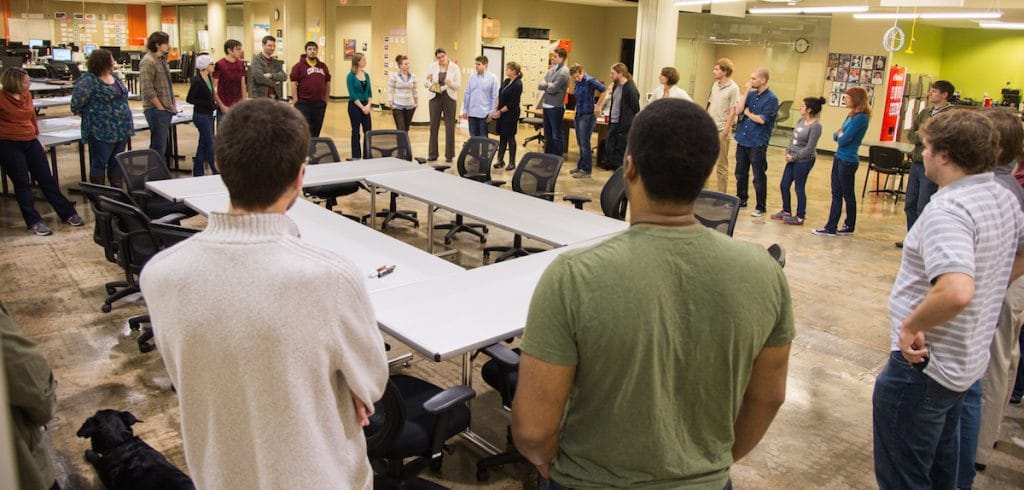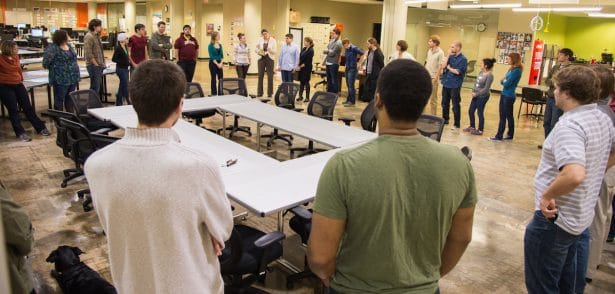Rich Sheridan, Menlo teach software development process to Rail Delivery Services, General Electric
After reading the book, Joy Inc.: How We Built a Workplace People Love, I was eager to interview Rich Sheridan. (He’s one of our keynote speakers at this fall’s PNSQC Conference and is the guest of a PNSQC webinar this Wednesday.) I spoke at length with Sheridan and wrote a couple of articles based on our interview.
What’s happened at Menlo Innovations, the company he co-founded, is inspiring. (You can read more about that here or by reading his book.) But, I asked him, is this a one-off phenomenon that only works so well at Menlo because the three co-founders all agreed on the business model? Does it only work for software companies? While thousands of curious folks journey to Ann Arbor, MI, to visit the facility, do any leave saying, “I’ve got to do that at my workplace!”
“Why don’t you ask some of the people who’ve adopted our model?” he asked.
So I did.
I spoke with Ron Sail, who ran a major unit within General Electric that supplied employees globally with such services as retirement benefits and executive compensation. (He recently retired.) Sail had built an open culture within the sprawling corporation. But he wanted more teamwork and productivity. His team agreed to do a “lean transformation” of the workplace. To get started, he attended a conference on lean management.
Among the speakers was Sheridan. “I got very excited about what I heard,” Sail said. “I thought, ‘This is the kind of culture we need to drive for.’”
Sheridan invited Sail’s leadership team to Menlo, and they came away convinced it was the way to go. “I didn’t edict anything that we saw,” he said. “I just asked people to experiment and decide what aspects could work for us.”
It took time to get everyone on board. The open workspace can be particularly difficult to implement, given that people have to give up their offices, their individual space, and their privacy. But when they began to see the results, a change came over the workplace.
“When we opened up the environment the new people loved it. The veterans had to adjust, and they were won over by the sharing and learning,” Sail said. “For instance, it used to take us three to six months for new people to learn payroll. Now they could do it in four to six weeks because of the open environment and sharing.” One new hire was running payroll for GE after just four weeks–a stunning reduction in the learning curve that resulted from the support and input she got through partnering and the open environment.
“There were certain elements of Joy that worked best,” Sail said. “Rich’s people taught a class to my leaders on high tech anthropology in the workplace, how to observe and really learn. People learned so much from that process. And the idea of experimenting with something new and not labeling the outcome as a success or failure but as a learning experience. That’s a huge difference in the way we looked at initiatives.”
Failure not possible? Mistakes not punished? Within GE, something big was shifting. And other departments were noticing.
“GE was always commanding and control. GE is trying to soften its culture, we happened to be ahead of it. Suddenly we had a lot of people from [other divisions in] GE come to my business and getting excited by what they saw. It is changing the larger culture from within, that’s what ended up happening.”

The morning stand-up meeting is among the workplace practices at Menlo that impressed visitors like Dave Porter and Ron Sail. (Photo courtesy of Menlo Innovations)
Dave Porter, CEO of Fontana, CA-based Rail Delivery Services, is another converted Menlonian. Rail Delivery Services (RDS) offers trucking services but also designs the software its dispatchers and other employees use to keep the trucks moving.
Rail Delivery belongs to the Intermodal Association of North America (IANA). Menlo was brought in to rescue an IANA software project, and Rail Delivery’s leaders were impressed. RDS then hired Menlo to co-develop their next-generation dispatching software and were blown away by both the results and the process Menlo brought to the project and RDS.
Menlo brought its paired programming process to the project–but in this case, a Menlonian was paired with a Rail Delivery programmer. With Menlo in Ann Arbor and RDS in the Los Angeles area, both teams worked together via Skype, moving forward with a discipline and effectiveness that Porter hadn’t seen before.
Other elements of the Menlo process that led to a successful, on-time release included Menlo’s estimation process and its emphasis on quality control.
“The estimation process identifies tasks that might be more complex than what a typical user would be aware of. Estimation defines the task to be coded and the amount of time to be allotted. It builds in accountability for the time estimation. It defines the boundaries of a task to stay within the timeframe, so you’re not going down rabbit holes. Following estimation, estimation cards are prioritized for the next weeks’ work schedule. Progress is evaluated by users and executive management on a weekly or bi-weekly basis. Everyone is always fully in the loop on the status of the project and any problems with the look, feel, or functionality is caught at the next weekly review session. This keeps the project on track and in alignment with its objectives.”
Porter admits that Menlo’s insistence on high-level testing was something new.
“We didn’t have a grip on that before. When a developer pair is working on a card and thinks it’s completed, they will take it to another developer pair for testing. They try to break it. If it breaks, back it goes. If not, we know it’s ready to move forward.”
Rail Delivery has adopted other elements of the Menlo way and continues to benefit from its exposure to the Ann Arbor software maker.
“We’ve often commented that besides the software we jointly worked on, a huge benefit we received through the Menlo engagement was helping us to optimally structure our own development processes for the future,” Porter said. “It is probably more valuable than the software we jointly produced. In fact, I guess you could say we’ve become Menlonians.”




